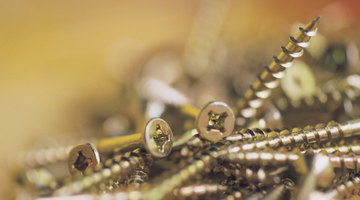Self-Tapping Screws Vs. Drywall Screws
The basic purpose for using a screw is to attach two items together. From a distance, all screws look pretty much alike, but when you’re attaching a cabinet to a metal, you don’t want to use a drywall screw.

Likewise, a standard self-tapping screw will probably tear the protective face paper if you try to use it to install drywall. Using the right kind of screw for the job will make the job simpler, and you’ll end up with higher-quality finished product.
Self-Tapping Screws
A self-tapping screw “taps,” or cuts its own thread path as you insert it, unlike screws that require a threaded hole, usually for insertion into heavy-gauge metal. Self-tapping screws are available with standard tips that require a pilot hole, or you may purchase self-drill/self-tapping screws that feature a drill bit-like tip that bores its own hole. Regular metal screws are fine for light-gauge metal, but on thicker gauge, a regular metal screw can twist in the hole, making it tough to get it in straight.
Drywall Screws
Drywall screws have aggressive threads, and if you roll one between your fingers, you’ll notice that the grooves between the threads are slightly deeper than the grooves on a regular screws. This enables a drywall screw to “grab” the compressed gypsum particles that make up a drywall panel, without causing the gypsum to crumble. That’s not the only special characteristic of a drywall screw. Hold the screw sideways and look at the head. A drywall screw does not have a flat head like other screws. The head of a drywall screw tapers in a trumpet shape. This allows you to countersink the screw when installing drywall without tearing the protective paper facing.
Self-Tapping Drywall Screws
Just when you thought you knew the difference between a drywall screw and a self-tapping screw, they come up with a self-tapping drywall screw, intended for installing drywall panels on light-gauge metal studs. If you’re attaching drywall to heavy-gauge metal, look for self-drill/self-tapping drywall screws. A self-drill/self-tapping drywall screw features a small drill tip, deep-grooved threading and the trumpet head of a drywall screw.
Application
To install self-tapping screws, use a drill with a screw chuck that fits the head of the screw or you may use a screw gun that holds clips of screws. A self-tapping screw with a drill tip relies upon spinning action to bore a smooth hole in the metal before the screw threads grab. Theoretically, you could install regular drywall screws with a manual screwdriver, but it would be a tedious process. The alternative method of attaching the panels is to nail them to the studs.
References
- “Working with Drywall: Hanging & Finishing Drywall the Professional Way”; Bryan Trandem; et al.; 2009
- SeekPart.com: Phillips Countersunk Head Self-Tapping Drywall Screws
Writer Bio
Glenda Taylor is a contractor and a full-time writer specializing in construction writing. She also enjoys writing business and finance, food and drink and pet-related articles. Her education includes marketing and a bachelor's degree in journalism from the University of Kansas.
Photo Credits
- Comstock/Comstock/Getty Images
- Comstock/Comstock/Getty Images
More Articles



